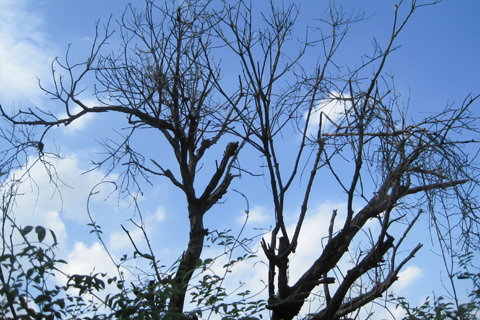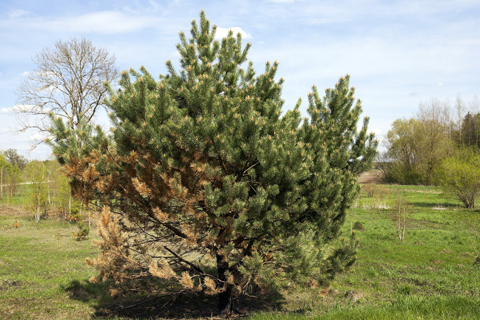Notice: Undefined variable: page in /home/vrxdg1855sn3/public_html/wp-content/themes/72tree/content.php on line 15
Notice: Trying to get property 'ID' of non-object in /home/vrxdg1855sn3/public_html/wp-content/themes/72tree/content.php on line 15
My Tree is Dying from the Top Down

What causes a tree to die from the top down? A common reason for a tree to die from the top down or from its outer limbs is drought. Even with reasonable rainfall, your tree may not be getting the water it needs to thrive and survive.
When a tree begins to deteriorate from the top down, this condition is also known as dieback. Dieback is the gradual death of tree branches, foliage, and/or limbs starting at the tips (extremities) and moving inward toward the trunk. Dieback, as mentioned above may result from drought. However, there may be a variety a variety of causes contributing to the gradual death of your tree.
The following will help you to identify what is causing dieback, the options available to save the tree, and the actions you can take to prevent the tree’s death.
What Can Cause Dieback from the Top Down?
In order to identify the cause of dieback, you need to know what you are looking for. The following are common reasons and symptoms when tree health declines.
Drought – Symptoms include the wilting or discoloration of leaves, limb, twig, and branch dieback, as well as the death of roots. Trees suffering from drought are very likely to be affected by insects, disease, or both.
Soil Imbalance – Soil is composed of minerals, organic and inorganic matter, water, air, and has an acidic or alkaline pH level. When an imbalance of these levels occurs, nutrients needed for the tree’s survival may not be absorbed. This can certainly lead to dieback and death of the tree if not addressed.
A sure sign of soil trouble is the absence of worms, plant growth, and small insects. “Life” should be detected in your soil, if not your soil’s health needs attention.
Insect Infestation – Invasive insect species also cause or accelerate dieback. When trees are stressed, they produce more amounts of nitrogen, potassium and phosphorus. This in turn makes them more attractive to invasive insects that feed off them.
As an infestation grows, the tree becomes more stressed and in turn, produces more of the chemicals – attracting more insects. This process can become a self-reinforced loop, and the initial stressors now combined with the infestation will eventually lead to the death of the tree if not treated promptly.
NOTE: While trees have adapted their defenses and healing processes over the millennia, it is these same adaptations that may feed an insect infestation.
What Options Do I Have to Save My Tree?
For each of the causes listed above, there is a specific course of action to halt or even reverse it. Once the cause is identified, the following simple treatments may help to save your tree.
Drought Treatment – During dry seasons or when rainfall is scarce, give your trees a thorough watering once a week. Make sure that the soil is soaked to a depth of at least twelve inches. Mulching around your trees base will slow the evaporation process and help the soil and tree retain moisture.
Soil Imbalance Treatment – While calling in a Certified Arborist may be the best option here, you are perfectly capable of getting a soil test kit from your local nursery or home improvement store (gardening department). Use the kit to determine if there is an imbalance for the species of affected tree(s), then seek appropriate soil treatments to return the soil to a healthy composition.
Insect Infestation Treatment – Once an infestation is confirmed, insecticides, traps, and oil can be used to kill the existing insects and prevent further infestation. Read this 72tree.com/using-dormant-horticultural-oil-treat-tree-insect-infestations/ for more on using and applying oils to treat insect infestations.
It is important to note that insect infestations are typically the result of a tree already stressed or in bad health. Once the infestation has been dealt with, begin looking for other stressors that may have lead to the weakening of the tree’s health.
How Do You Save a Dying Tree?
When dieback occurs, saving your tree will involve pruning or trimming off the dead parts of the tree, and identifying the reason that the dieback occurred. Once identified, treat it. If it is an infestation that is threatening other trees and plants, you may have to make the decision to completely remove the tree to prevent further contamination and damage.
Proper Treatment and Prevention – Once you have treated the cause of your tree’s dieback, understand that you can save a dying tree by simply paying attention to it through the seasons. Your tree will show signs of stress, and once you detect it, consider it a call to action.
It is equally important to establish and follow seasonal maintenance and care. Bringing in a Certified Arborist or reputable tree service to inspect your trees and landscape will help give you the upper hand in keeping your trees healthy!
Notice: Undefined variable: page in /home/vrxdg1855sn3/public_html/wp-content/themes/72tree/content.php on line 15
Notice: Trying to get property 'ID' of non-object in /home/vrxdg1855sn3/public_html/wp-content/themes/72tree/content.php on line 15
Signs of a Diseased Tree – Dieback, Tree Suckers & Water Sprouts
 Spruce with dieback needs tree care to preserve healthy landscape.
Spruce with dieback needs tree care to preserve healthy landscape.
Many diverse diseases affect your landscape, shrubs and trees. Identifying these diseases is critical because, not all tree diseases can be controlled. We love to watch things grow when we garden but we must note that not all growth is positive or advantageous to the trees. Some of these growths take energy away from the tree; common examples include water sprouts and suckers. At 72tree.com we often see the damaging effects of tree disease, and in this article, dieback, tree suckers and water sprouts are the disorders we’ll be discussing.
Dieback of a Tree or Its Limbs
In spring as the weather gets warmer, and buds start noticeably leafing out, you might notice that a section or even an entire limb is not leafing out consistent with the rest of the tree. Dieback is a condition in which the ends of the tree branches die. These sections are generally located at the limb tips, but can also be entire limbs or sections of the tree where there will be no leaves. Most times, this is a sign that all is not right with the tree.
Water Sprouts Due to Branch Removal
Water sprouts are dynamic shoots that develop from dormant buds either on large branches or trunks of a tree. They are usually upright and in many cases occur as a result of the removal or trimming of large branches. Heavy pruning may also lead to the production of more sprouts. Tree stress may also result in water sprout growth, but it’s not usually as vibrant as those that occur due to pruning.
Trees should be checked regularly. If you notice new shoots, eliminate them by rubbing them off as they emerge. Large water sprouts can be pruned off close to the trees trunk. Water sprouts can ruin a tree’s shape and they also divert the tree’s energy by blocking air circulation and light. Though not advised, some allow sprouts to grow in the place of missing branches, but it may lead to a reduction in quality of the tree’s ability to bear more fruits. Also, water sprouts are more inclined to promote tears, disease and breaks, as they are generally weaker than other branches.
Tree Suckers
Suckers are un-planned, vegetative growths that stem from a tree’s root system. Suckers grow from rootstock and divert nutrients away from the trees top growth. There isn’t any actual benefit from letting suckers grow because, rootstocks are usually different from the type of tree that you planted (example – a Gala apple tree will not have a Gala apple rootstock).
To find and cut from the base of a sucker, you may have to pull back any ground cover and dig up some soil to fully expose the sucker. Ensure that as much growth as possible is removed to reduce the potential of them popping up again. If they do re-emerge, this simple process will have to be repeated. Although suckers and water sprouts are similar, remember suckers originate from the root or base of the tree.
Tree Disease Prevention and Care
You might be able to deal with a disease that occurs on your trees and shrubs but you ought to consider consulting a local arborist or tree service professional if you are uncertain. The arborist will identify any disease and offer you the best treatment options and the ideal time to care for the tree.
Early spring (during most maintenance pruning) is the best time to remove both water sprouts and tree suckers. However, these unwanted growths sometimes sprout and occur during the growing season, they should be removed as soon as you notice their existence. Your trees will thank you and be fruitful!
